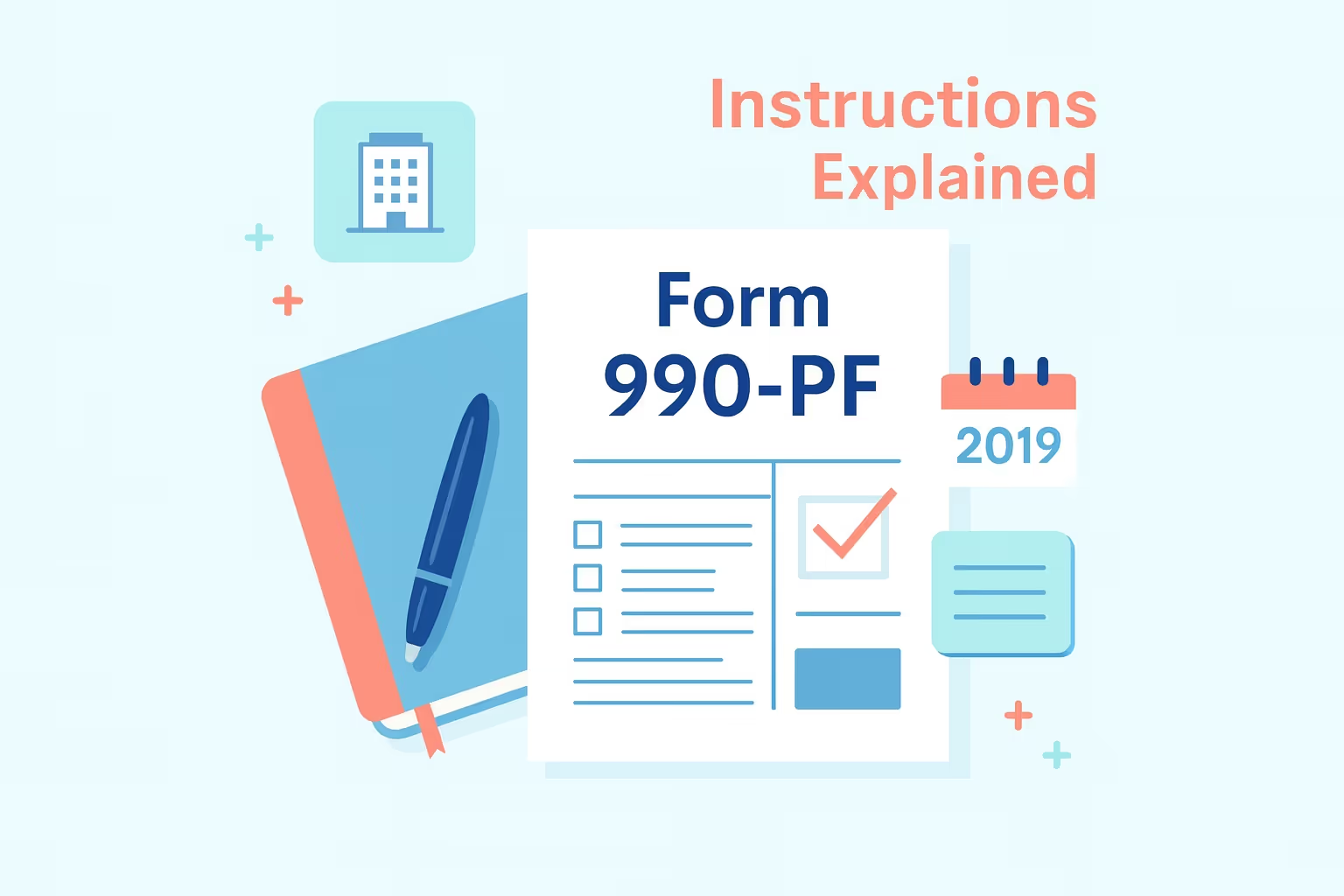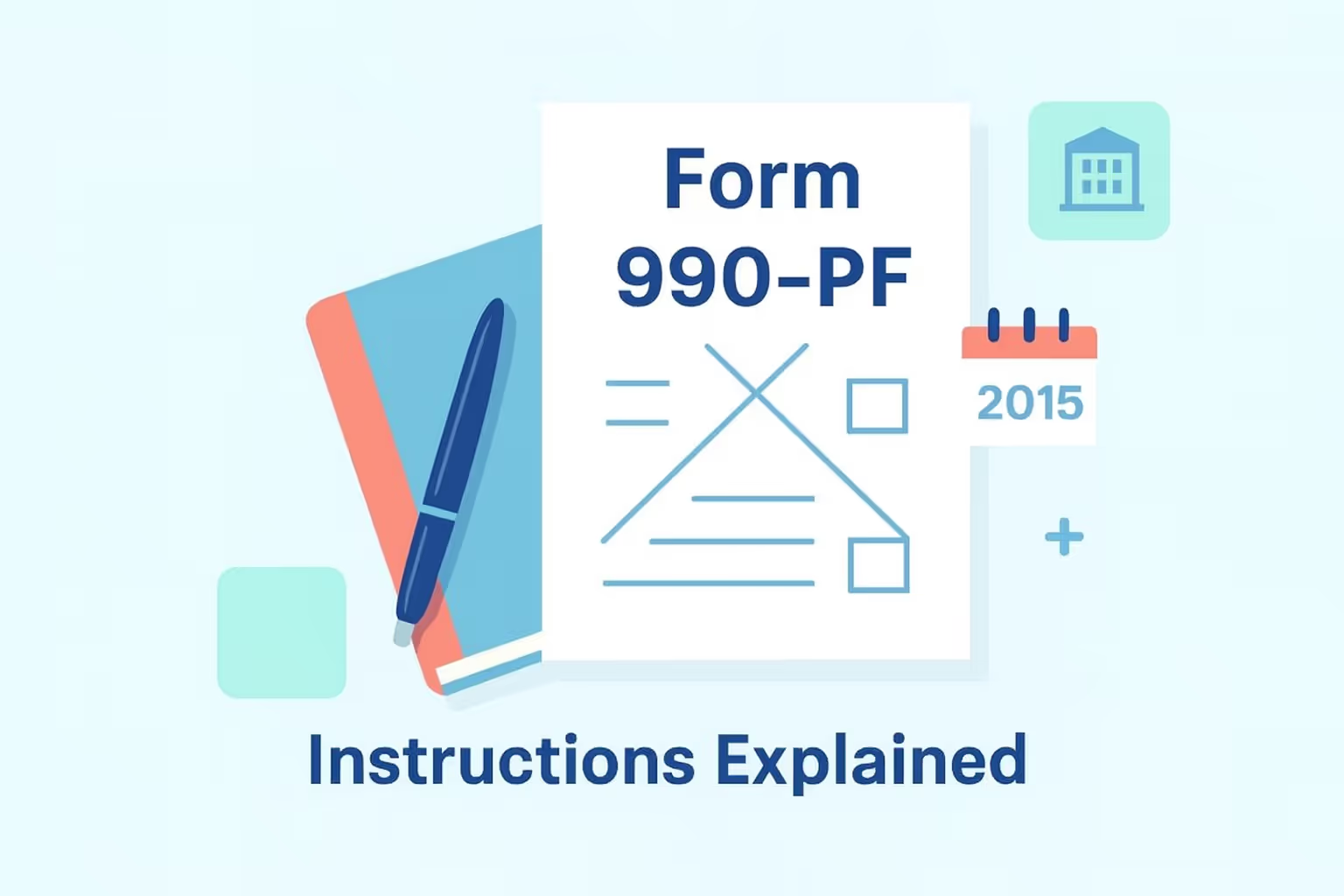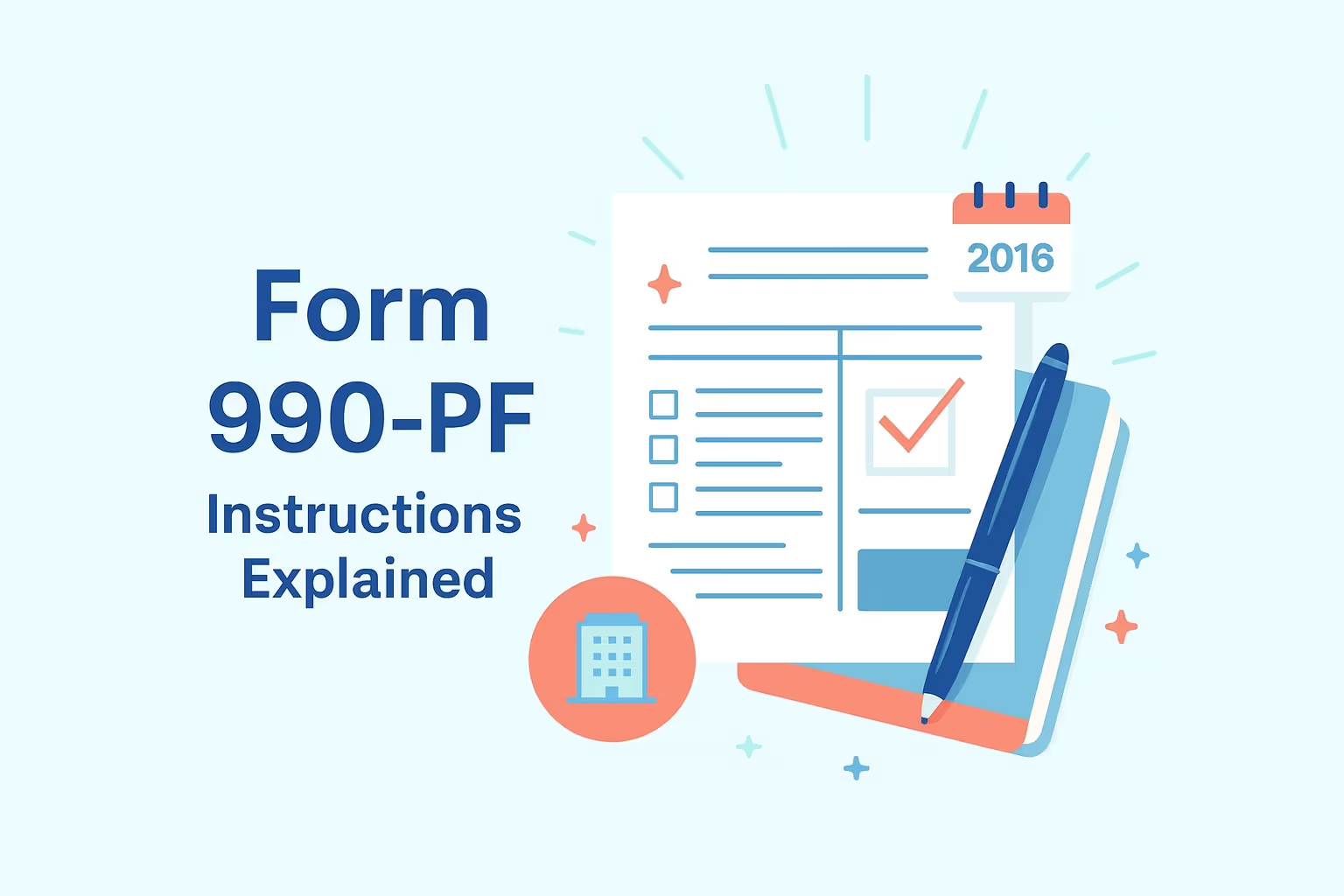Form 990-PF 2011 Instructions for Private Foundations
Form 990-PF is an annual information return required by the Internal Revenue Service for private foundations and nonexempt charitable trusts. It reports the organization’s income, expenditures, contributions, and program activities for tax years ending within the filing period. Completing this return helps tax-exempt organizations comply with the Internal Revenue Code and maintain their exempt status. Accurate reporting assures government agencies that the organization’s activities align with charitable purposes and meet federal filing requirements.
Private foundations and nonprofit organizations must disclose their financial activity in detail, including grants, program-related investments, and compensation paid to responsible persons. Each filer must also confirm that all reported figures have been reviewed and that financial records are retained for verification. Transparent reporting strengthens public trust and demonstrates that funds are correctly allocated across charitable categories, programs, and services.
The IRS Form 990-PF Overview explains that all private foundations are required to submit an annual return, regardless of their income level or activities. The IRS page clarifies who must file, which organizations qualify as tax-exempt under the Internal Revenue Code, and how reasonable cause provisions apply when a foundation is unable to meet filing deadlines.
Understanding IRS Form 990-PF
Form 990-PF serves as the primary annual return for private foundations and nonexempt charitable trusts treated as private foundations under the Internal Revenue Code. The Internal Revenue Service uses the information reported on this form to evaluate financial transparency, program compliance, and adherence to laws governing tax-exempt organizations. Each filer must provide accurate data to retain tax-exempt status and avoid compliance issues that may affect the filer’s standing.
The form requires organizations to disclose financial details that reflect their activities for tax years ending within the reporting period. Each section ensures that the foundation documents its income sources, distributions, and expenditures that align with its charitable purposes and objectives. Detailed reporting strengthens accountability and confirms the organization’s commitment to serving public interests rather than private gain.
Who Must File Form 990-PF
- Private Foundations: All entities classified as private foundations under section 509(a) must file annually, regardless of financial activity or income amount.
- Nonexempt Charitable Trusts: Trusts treated as private foundations under section 4947(a)(1) must submit the return to demonstrate compliance with the Internal Revenue Code.
- Organizations Awaiting Tax Exemption: Entities applying for recognition as tax-exempt must still complete Form 990-PF until the Internal Revenue Service approves their status.
- Foundations Changing or Ending Status: Any organization that terminates operations, merges, or converts from a public charity to a private foundation must report its final activities.
Information Required in the Return
- Revenue Reporting: Identify all income, including investments, grants, and contributions from donors or government agencies.
- Program Expenditures: List spending connected to charitable services, operational costs, and qualified distributions.
- Compensation Disclosure: Include salaries, benefits, and payments made to officers, trustees, and key employees responsible for foundation operations.
- Asset Details: Include balance sheet figures, valuation methods, and descriptions of property or securities held throughout the tax year.
- Grantmaking Activities: Document all contributions made to other tax-exempt organizations or charitable programs.
Consequences of Incomplete or Missing Filings
- Automatic Revocation: The Internal Revenue Service will revoke tax-exempt status if a foundation fails to file for three consecutive years.
- Loss of Public Trust: Missing or inaccurate returns may reduce credibility and affect relationships with contributors and partner nonprofits.
- Reinstatement Process: Foundations that lose exemption must reapply and meet reasonable cause requirements to restore compliance.
Comprehensive and accurate filing demonstrates accountability, preserves compliance with the Internal Revenue Code, and confirms that the organization’s financial management aligns with charitable objectives. Each foundation’s leadership should carefully review the data to ensure that reporting accurately reflects lawful operations and responsible stewardship of funds.
Filing Deadline and Due Date
Every private foundation, nonexempt charitable trust, and nonprofit organization that files Form 990-PF must meet the annual deadline set by the Internal Revenue Service. Timely submission helps maintain tax-exempt status and demonstrates compliance with the Internal Revenue Code. Meeting due dates also reinforces responsible financial oversight.
Standard Filing Deadlines
Form 990-PF is due on the 15th day of the fifth month after the close of the organization’s accounting period. For calendar-year filers, the deadline for the 2011 tax year was May 15, 2012. If the due date falls on a weekend or legal holiday, the return must be filed on the next business day.
Each filing must reflect income, expenditures, and distributions for tax years ending within the reporting period. Maintaining an organized filing calendar helps prevent missed deadlines or reporting discrepancies. Regular planning ensures accurate data submission and long-term compliance.
Organizations should review reporting schedules early in the year. Assigning a staff member to track filing progress increases accountability and supports record accuracy. Retaining documentation that confirms timely submission supports audit readiness and future verification.
Timely filing strengthens public trust and helps organizations maintain eligibility for continued exemption. Late submissions may trigger additional review and potential scrutiny from oversight agencies. Consistent reporting demonstrates the organization’s commitment to transparency and proper stewardship of charitable resources.
Requesting an Extension
Organizations that require additional time may request a six-month automatic extension using Form 8868. The extension applies only to filing, while any tax owed must still be paid by the original due date. Late payments can trigger interest charges or compliance issues under the Internal Revenue Code.
Foundations must document reasonable cause when delays occur. Supporting evidence may include correspondence, meeting records, or accounting documentation explaining the filing delay. These records help demonstrate a sincere effort to meet Internal Revenue Service requirements.
Payments should be scheduled through the Electronic Federal Tax Payment System. Initiating transactions before the due date ensures timely processing and proof of payment. Each organization should verify the accuracy of its filing before submitting it.
The IRS Annual Filing and Forms page details official due dates, extension options, and payment procedures. Reviewing this resource supports timely compliance with federal reporting obligations. It also helps organizations confirm their filing category and understand ongoing requirements.
Tax Year 2011 Considerations
The 2011 tax year introduced regulatory changes that affected how private foundations, nonexempt charitable trusts, and nonprofit organizations reported their financial activities to the Internal Revenue Service. Understanding these updates is crucial for organizations seeking to maintain their tax-exempt status and ensure compliance with the Internal Revenue Code. Each rule change addressed how foundations manage payments, file returns, and maintain eligibility as tax-exempt entities.
The IRS required all depository tax payments to be made through the Electronic Federal Tax Payment System starting January 1, 2011. Paper deposit coupons, such as Forms 8109 and 8109-B, were discontinued at the end of 2010. The transition to electronic payments improved accuracy, reduced delays, and ensured faster processing for organizations across charitable categories.
Organizations eligible for the small employer health insurance credit, introduced under the Affordable Care Act, must use Form 990-T. The credit could not be claimed on Form 990-PF, even by tax-exempt organizations or nonexempt charitable trusts. This rule ensured clarity between reporting for exempt operations and unrelated business income while preserving consistency across government agencies managing tax-exempt filings.
- EFTPS Mandate: Beginning January 1, 2011, organizations had to submit all tax deposits electronically, replacing paper coupons.
- Health Insurance Credit Reporting: The Affordable Care Act credit had to be claimed on Form 990-T, not Form 990-PF.
- Automatic Revocation Rule: Organizations that fail to file for three consecutive years lose their tax-exempt status and require reinstatement.
- Initial Return Designation: Foundations transitioning from public charity status were required to mark “Initial return of a former public charity” in Block G.
- Enhanced Recordkeeping: Filers were expected to maintain reviewed and verified records to support reported income, expenditures, and grants.
The 2011 tax year also marked stricter enforcement of the automatic revocation rule. Any organization that failed to file annual returns for three consecutive years faced the loss of its tax-exempt status. To regain recognition, affected entities needed to reapply and demonstrate reasonable cause for noncompliance.
The IRS Private Foundations page provides information on current compliance standards, eligibility requirements, and official filing guidance. Reviewing this resource supports accurate reporting and helps organizations adapt to evolving regulatory expectations.
Applying these 2011 updates correctly demonstrates accountability and strengthens public trust. Each change reflects the Internal Revenue Service’s broader effort to streamline oversight and encourage reliable recordkeeping among tax-exempt organizations.
Step-by-Step Filing Instructions
Filing Form 990-PF requires accuracy, planning, and attention to every financial detail reported to the Internal Revenue Service. Each section captures specific data regarding income, expenditures, and charitable distributions as outlined in the Internal Revenue Code. This step-by-step process combines narrative, bullet points, and numbered guidance to help private foundations, nonexempt charitable trusts, and nonprofit organizations complete the return accurately and efficiently.
Step 1. Gather Essential Documentation
Review your organization’s financial records thoroughly. Gather supporting documents that show all activity for tax years ending within the filing period. Include:
- Financial Statements: Provide income summaries, balance sheets, and expense reports that reflect the foundation’s financial position.
- Contribution Records: List all donations, grants, and funding sources received during the tax year.
- Investment Details: Document all securities, dividends, and capital gains associated with organizational investments.
- Payroll Reports: Record compensation, benefits, and total hours worked for officers, directors, and staff members.
Ensure each figure matches verified internal data before completing the return.
Step 2. Complete Entity Information
Provide the foundation’s legal name, mailing address, and employer identification number. Indicate the tax year-end date and the classification under the Internal Revenue Code. Organizations transitioning from public charity status must check “Initial return of a former public charity” in Block G to identify their first private foundation return.
Step 3. Report Revenue and Expenditures (Part I)
Disclose all income sources, including grants, interest, and contributions. Separate charitable expenditures from general administrative expenses. Confirm that each total matches the financial statements and grant records to ensure complete reporting.
Step 4. Record Balance Sheet Details (Part II)
Document beginning and end-of-year balances for all assets, liabilities, and net assets. Report the fair market value of property, securities, and investments as required. Balanced figures demonstrate sound financial management and compliance with tax-exempt reporting rules.
Step 5. Address Changes, Capital Gains, and Compliance
Summarize any adjustments in net assets, noting gains, losses, or reallocations. Provide schedules for realized and unrealized capital gains or losses, including transaction details and valuation methods. Respond accurately to all compliance questions in Parts VII-A and VII-B, and attach statements when further explanation is required.
Step 6. Identify Officers and Key Employees (Part VIII)
List every director, trustee, or officer who manages the organization. Include names, titles, average weekly hours, and total compensation. Transparent reporting supports accountability and public trust in nonprofit leadership.
Step 7. Calculate Distributions, Review, and File
Determine excise taxes, qualifying distributions, and minimum payout requirements. Verify totals across all sections and schedules. The authorized individual must sign the return to confirm accuracy, then retain a complete copy for permanent records.
A detailed, organized approach ensures the foundation meets IRS requirements and protects its tax-exempt status. Accurate filing demonstrates integrity and reinforces responsible governance.
E-Filing and Paper Submission
Private foundations, nonexempt charitable trusts, and nonprofit organizations must submit Form 990-PF accurately using an approved filing method. The Internal Revenue Service encourages electronic filing for most tax-exempt organizations to ensure faster processing and reduce reporting errors. Choosing the correct method depends on filing volume, organization size, and system readiness.
Electronic submission improves accuracy, provides faster confirmation, and reduces the likelihood of processing delays. The IRS mandates electronic filing for organizations submitting 250 or more returns annually. Smaller foundations benefit from e-filing because it provides easier access to past submissions and payment records.
Benefits of E-Filing
- Faster Processing: The IRS receives and processes e-filed returns more efficiently than mailed submissions.
- Error Reduction: Automated validation checks identify missing information and inconsistencies before final submission.
- Instant Confirmation: Electronic receipts confirm the exact date and time of successful filing.
- Secure Records: Digital filing allows organizations to retain accessible electronic copies for future review.
- Efficient Payment Options: Authorized users can make Electronic Funds Withdrawals through their IRS accounts.
Foundations should review all sections for completeness before uploading their return. A final review ensures income, expenditures, and balance sheet totals match supporting documentation. Maintaining a copy of the signed return confirms accuracy and supports future audits.
Paper Filing Option
Organizations that do not meet e-filing requirements may submit paper forms instead. Paper submission is permitted only when the organization files fewer than 250 returns annually or receives a hardship waiver from the Internal Revenue Service. Filers using paper forms must mail their completed returns to the address specified in the current IRS instructions.
Each paper return must be typed, complete, and signed by an authorized individual. Submitting incomplete or handwritten forms may cause delays or rejection of the filing. Retaining a dated copy provides proof of filing and a reference during compliance reviews or exemption renewals.
Both electronic and paper filing methods support compliance with federal reporting requirements. Selecting the most reliable submission process helps ensure timely acceptance and protects the organization’s tax-exempt status. Accurate filing confirms an organization’s commitment to transparency, good governance, and adherence to the Internal Revenue Code.
Payment Methods and EFTPS Requirements
Private foundations, nonexempt charitable trusts, and nonprofit organizations must submit accurate payments when filing Form 990-PF. The Internal Revenue Service requires electronic deposits through the Electronic Federal Tax Payment System for most entities. Understanding each payment option ensures timely deposits, preserves tax-exempt status, and confirms compliance under the Internal Revenue Code.
- Payment Deadline: All payments must be completed by the same deadline as the Form 990-PF filing. Organizations using EFTPS should initiate transactions at least one business day before the due date. Early scheduling prevents delays and guarantees processing within the designated tax year.
- EFTPS Registration: Each foundation must register through the Electronic Federal Tax Payment System before making deposits. Registration requires a valid employer identification number and a linked bank account. Completing the setup early ensures organizations can make payments without interruption or missed deadlines.
- Transaction Process: Once registered, organizations log into EFTPS, enter the required tax period, and specify the payment category. Accurate input ensures that deposits are applied to the correct account and tax year. Submitting transactions before the cutoff time ensures same-day crediting.
- Small Foundation Option: Organizations owing less than $500 in excise taxes may include payment with the paper return. Eligible filers can attach a check or money order payable to the United States Treasury. The payment must match the total reported on Form 990-PF, Part VI.
- Proof of Payment: Retain EFTPS confirmation numbers and dated payment records. These serve as official verification of timely deposits. Documentation also supports future reviews, audits, or exemption renewals.
- Common Errors: Late payments, incorrect account selection, and incomplete registration often result in compliance issues. Foundations should verify all data before submission and confirm receipt through EFTPS. Regular monitoring reduces the likelihood of errors across reporting cycles.
- Support and Assistance: The Internal Revenue Service provides technical support for EFTPS users. Contacting the service line can help resolve registration issues, access concerns, or deposit discrepancies. Maintaining direct communication with support teams ensures accurate payment posting and processing.
Using EFTPS streamlines tax deposits, reduces administrative burden, and ensures reliable tracking of payments throughout the year. Following established procedures confirms each organization’s commitment to transparency, fiscal responsibility, and adherence to federal reporting requirements.
Required Schedules, Attachments, and Common Errors
Completing Form 990-PF accurately involves submitting the correct schedules and attachments that support the organization’s financial disclosures. Each required document provides detailed information about revenue, expenditures, grants, and operational activities. Including accurate schedules reinforces transparency and ensures compliance with the Internal Revenue Code.
Below summarizes key schedules, their descriptions, and their intended purposes for private foundations, nonexempt charitable trusts, and nonprofit organizations:
- Schedule B
- Description: Lists all contributors who donated $5,000 or more in money, securities, or property
- Purpose: Verifies significant contributions and supports transparency for donor reporting requirements
- Schedule I
- Description: Details domestic grants made to organizations or individuals during the tax year
- Purpose: Confirms charitable distributions meet program objectives and legal standards
- Schedule XIV
- Description: Reports information for private operating foundations, including direct charitable activities
- Purpose: Demonstrates fulfillment of operational requirements under the Internal Revenue Code
- Schedule XV
- Description: Provides data on grants and assistance paid to foreign organizations or entities
- Purpose: Ensures compliance with international regulations governing charitable giving and donations
- Supplemental Attachments
- Description: Includes explanations, supporting statements, depreciation schedules, and similar documentation
- Purpose: Clarifies complex entries or balances requiring additional detail
Formatting and Submission Requirements
Each organization must attach additional statements where “Yes” answers appear in Parts VII-A or VII-B. These explanations supply context for operational activities that may raise compliance questions. Foundations must also include schedules detailing legal, accounting, and professional service fees paid during the reporting period.
Attachments should be formatted clearly, using the same page size as the return. Each page must list the organization’s name, employer identification number, and tax year ending date. Number all attachments consistently, and indicate the corresponding section or line item they support. Accurate labeling prevents misplacement and streamlines IRS review during processing.
Common Filing Errors and Prevention
Common filing errors include missing schedules, incorrect totals, or inconsistent data across sections. Omitting fair market values from balance sheets or leaving unanswered compliance questions are frequent mistakes. Failure to list officers and compensation details may lead to requests for additional information or delayed approval of exempt status renewals.
Organizations can minimize errors by reviewing every entry before filing. Cross-checking totals, verifying that all required schedules are attached, and maintaining organized records support compliance with federal standards. Assigning a qualified preparer or using e-filing software with built-in validation features helps detect discrepancies early.
Comprehensive documentation confirms the organization’s commitment to accurate reporting and responsible management of charitable resources. Including every necessary schedule and attachment ensures that regulators and donors are aware that the foundation operates with integrity and adheres to established tax-exempt guidelines.
Frequently Asked Questions
What is the filing deadline for Form 990-PF for the 2011 tax year?
The filing deadline for Form 990-PF is the 15th day of the fifth month after the organization’s accounting period ends. For example, a foundation using a calendar year must submit its tax return by May 15, 2012. If the due date falls on a weekend or a legal holiday, the filing deadline is extended to the next business day. Meeting deadlines ensures compliance and prevents the foundation from receiving an Internal Revenue Service notice for late submission.
Are there exceptions to filing requirements for small or inactive foundations?
Most private foundations, including those that are dormant, are required to file Form 990-PF on an annual basis. Exceptions apply only to entities formally dissolved or excluded under specific provisions of the Internal Revenue Code. Even inactive filers must report assets, prior-year obligations, or distributions. Completing required schedules ensures transparency and avoids potential compliance actions for late or missing filings. Every submission must reflect accurate data that are consistent with the foundation’s operational and financial activities.
How should a foundation respond if it receives an IRS notice about missing information?
When a foundation receives an IRS notice requesting clarification, it should respond promptly with the required documents and explanations. Each response must address the subject mentioned in the letter, referencing line items or schedules when applicable. Maintaining clear records supports a timely resolution and demonstrates a good-faith attempt to comply with reporting standards. Quick action helps preserve the organization’s good standing and prevents additional correspondence or follow-up reviews.
What happens if a foundation submits its tax returns after the due date?
A late submission may result in a monetary penalty, calculated based on the organization’s total assets and the duration of the reporting delay. The IRS expects timely filings that meet established standards for quality and accuracy. Organizations can request relief if they show reasonable cause and provide supporting documentation. Filing promptly and maintaining internal reminders ensures future returns meet deadlines, reducing the likelihood of repeat issues or further compliance inquiries.
How can organizations improve the quality of their filings?
Foundations can enhance reporting quality by undertaking early preparation and conducting thorough internal reviews. Each section of Form 990-PF should be cross-checked against accounting records, grant summaries, and prior-year filings to ensure accuracy. Using e-filing software with validation features helps identify missing entries or inconsistencies. It is also helpful to consult professional tax advisors for complex issues. Properly reviewed returns reduce errors, reinforce accuracy, and maintain organizational credibility during IRS examinations.
Are hospitals and similar organizations required to file Form 990-PF?
Private hospitals classified as foundations must file Form 990-PF if they hold private foundation status. Publicly supported hospitals generally file Form 990 instead. Determining filing responsibility depends on classification under the Internal Revenue Code. Each organization should review its exemption letter and prior tax return history to confirm the appropriate form. Verifying status early prevents filing errors and ensures accurate disclosure of charitable programs and expenditures.
Where can filers find helpful resources and suggestions for completing Form 990-PF?
Filers can visit the IRS website and use the search function to locate official guidance on preparing Form 990-PF. Reviewing past submissions provides a clear example of required schedules and formatting. The IRS publication library also includes supplemental resources addressing common reporting concerns. Accessing verified materials helps organizations prepare accurate filings and understand specific exceptions, filing deadlines, and subject-based reporting requirements.




























